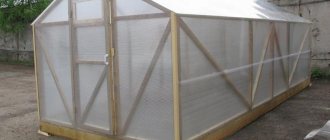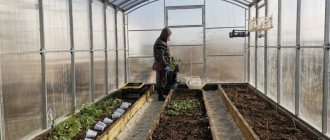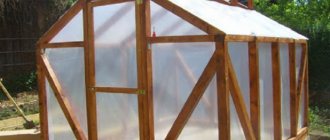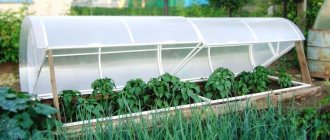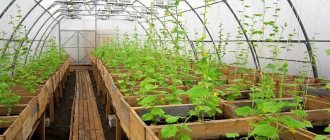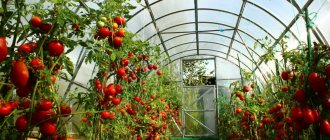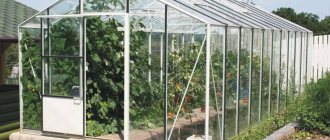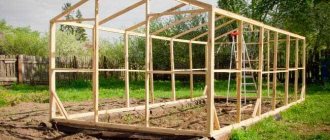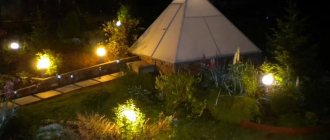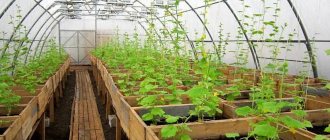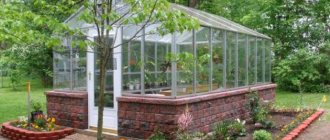The climate in most regions of Russia does not allow growing vegetables beloved by many in open ground - the risk of temperature changes is too great, which leads to the death of plantings. Cucumbers, tomatoes, tomatoes and other crops love warmth and stable temperatures, which can only be achieved by planting them in a greenhouse. In this article we will look at how you can make one of the simplest structures - a greenhouse made of wood - with your own hands and cheaply.
Advantages and disadvantages of a wooden greenhouse
Wooden boards and bars are best suited for building reliable and durable greenhouses. Wooden structures have a number of undeniable advantages:
- Easy to assemble. Wood is pleasant and easy to work with; the boards are easily sawed off and fastened together without much difficulty.
- Environmentally friendly material. The tree allows oxygen to pass through perfectly and does not emit substances when heated that can harm the plantings.
- Low cost. As a rule, boards can be found at any summer cottage. Even if there are not enough of them, you can purchase wooden boards and bars at any hardware store for a relatively low cost.
- Reliability. When assembled correctly, a wooden greenhouse is not afraid of gusts of wind or heavy rain, and the durable frame can withstand absolutely any covering material - from film to glass.
- Long service life. The pre-treated wood from which the greenhouse will be assembled will serve gardeners for a very long time - up to 7 years. And if all repair work is carried out on time, the period can double.
- Independent choice of area. A wooden greenhouse can be built according to purely individual dimensions, which depend on the scale of the site and the planned plantings.
Like any material, a wooden structure for a greenhouse has a number of specific disadvantages:
- Sensitivity to moisture. The tree does not tolerate regular exposure to moisture, so it needs additional processing. In addition, its direct contact with the soil is undesirable; it is better to make an additional foundation for the frame, raising the greenhouse at least 10 cm from the ground.
- High biosensitivity. The wooden elements of the greenhouse frame easily become victims of rot and mold, especially on the inside. Careful processing will help solve the problem, as well as the correct choice of wood if you purchase it specifically and do not use what is left after repair work.
- Regular processing. Wood requires special care and treatment must be carried out regularly; fortunately, stores offer a wide selection of various specialized products.
- The need to use narrow boards. If, after repairs, you still have too wide boards, then a frame made from them will provide too much shade, which can adversely affect the quality of growth of planted crops.
- The difficulty of creating arches. If you are planning to assemble an arched greenhouse, then wood is the least suitable for these purposes - it is impossible to bend the boards at home, so the arch can only be put together from small bars, which complicates the assembly process and makes the structure more vulnerable.
Covering material for greenhouses
High-quality wood can withstand quite significant loads.
Therefore, you can cover a wooden greenhouse using:
Polyethylene film
The simplest and most budget-friendly option for creating a cozy and warm home for plants will last a couple of years, after which it will have to be replaced. The disadvantage is the need to dismantle the film before the onset of heavy rains and cold weather. The film will have to be additionally strengthened on the frame, otherwise it will simply collapse from a strong wind, and it is strongly not recommended to pierce the material.
Polycarbonate
Transparent plastic sheet has higher performance characteristics. The material will easily withstand frosty winters, will not be damaged by rain or ultraviolet radiation, and can be attached directly to the frame beams. Polycarbonate will last 20-30 years, but installing it alone will be quite difficult.
Glass
Expensive and heavy material is rarely used for conventional greenhouses. The material is quite fragile, so you will have to be especially careful when handling tools when working inside the greenhouse. But the glass can be washed, providing additional light, and the shelf life is limited only by the carefulness of the owners.
Cozy wooden greenhouses will be an inexpensive and attractive decoration for any summer cottage, helping to obtain a high harvest.
Choosing wood
If you use boards from leftovers at your dacha, then choose the smoothest ones for the frame without chips or cracks. The optimal size is 50 by 50 for the main elements and 100 by 100 for the frame. Make sure that there are no signs of rot on the boards; one damaged element will subsequently lead to serious repairs to the entire structure.
If you plan to purchase wood in a specialized store, then choose industrial varieties, which include, for example, larch and pine. There is no point in spending a lot on beech or oak - they are more difficult to work with, and their service life is not much longer than that of other species. Pay attention to the humidity indicator - it should not be higher than 22%.
But even if you purchased the freshest wood, which, at first glance, does not need additional processing, still pre-plan it and impregnate it with a special composition. The finished greenhouse structure will need to be painted or impregnated with drying oil.
How to build a truly durable structure?
The main rule of durability and strength is the correct preparation of the wood itself for use. Therefore, no matter where you get the bars and no matter how good they look, be sure to first brush them from dirt and sand, rinse them and let them dry for enough time. After this, sand with medium-grit sandpaper or some wet abrasive.
The main thing is to ensure that a painted greenhouse made of wood does not become covered with cracks - if any appear, paint over them immediately, otherwise the material will immediately begin to absorb moisture and rot from the inside. The same applies to bubbles on the paint - clean the layer in such a place and prime the surface again. If, due to some mechanical damage, part of the frame is completely exposed, then use an aluminum primer to treat it: apply the first layer of paint and after a while - two more layers. Also pay attention to what kind of wood you are building the greenhouse from - if it is soft wood, then it will need to be painted twice a year.
Also, the antiseptic significantly extends the life of the structure - it protects it from the destructive effects of moisture.
Ready? Look for some drawing among those offered - and off you go!
Project No. 1
Project No. 2
Project No. 3
Choosing a construction site
The main rule for choosing a place for a greenhouse is not a centimeter of shadow! The structure should be located away from the main buildings and tall trees that can create additional shadow. It can be destructive for many plantings, even if it covers them for only an hour a day.
Another important rule is that the door to the greenhouse should be located on the side that is least exposed to winds; in no case should it be made on the north side of the site - the plants will constantly freeze and die when ventilated.
Stretch film structures
Not everyone knows, but stretch film can be used as a good building material for greenhouses. Let's consider an example of a structure with such a film. Its design measures 3 by 3 m and its height is 2.6 m.
For such an object, you should take a two-layer film with an air gap of 5 cm. In appearance, such a greenhouse does not differ from a regular one, but stretching the film over an arc has its own nuances.
What should you do to make such a greenhouse from wood under film with your own hands?
- First you need to cut the slats. They must have right angles.
- Before assembling the frame, the slats should be wrapped in cheap film having a width of 30 cm. It is better to do this tightly and in a spiral. It is planned to lay stretch film in the same layer. Why is which circle made? This makes it easy to cover any frame material with stretch film.
- You need to take a stretch film 50 cm wide. The first row should cover the rail from below, and then from above.
- If necessary, you can use transparent adhesive tape to secure the stretch film to the structure. Using this principle, you can assemble all the components of the structure, and at the end install a pipe to drain rainwater.
The whole process takes no more than 10 minutes. Stretch film is good because it maintains heat inside the structure and protects plants from wind and rain. A good alternative can be a light-stabilizing film.
Post Views: View statistics 1,160
Types of structures
The most popular type of greenhouses are gable structures. But, in addition to them, with the help of wooden elements, if desired, you can build other types of greenhouses.
from left to right, top to bottom: arched, domed, lean-to, pyramidal greenhouses
Arched
An arched greenhouse, as we said above, is almost impossible to make entirely of wood in domestic conditions. For its installation, additional elements will be required in the form of metal or durable plastic arcs. Only a frame can be made of wood, which is created for ease of installation and reliable fixation of the structure. As a rule, low greenhouses are built using the arched method; they have excellent light transmission and do not require large time and material costs. But high greenhouses can also have an arched roof, this allows them to grow freedom-loving crops. The downside of such a structure is that it is practically unsuitable for growing seedlings, since it does not have enough maneuvers to carry out hardening of plantings. Another disadvantage of the arched structure is the need for additional cleaning of the roof from snow, which cannot roll off the arched roof on its own.
Domed
In central Russia, such a greenhouse will become an unmotivated luxury, since it involves a rather complex and costly installation process from triangular cladding elements. But in seismically unfavorable parts of our country, it is precisely this design that will become the safest and most resistant to earth vibrations. In addition, the domed greenhouse looks very stylish and fits organically into the exterior of any site. This design requires additional insulation and sealing due to the large number of joints.
Single-pitch
Lean-to greenhouses look like half a house. They are usually built for planting seedlings on the south side of the site. Mono-pitch structures are convenient because they can be attached to any existing structures on the site, be it a barn, garage or gazebo. The main condition is good lighting of the place. It is recommended to cover the roof slope with glass or plastic, which have good light transmittance.
Pyramid
Since ancient times, the pyramid has been considered a mythical place of power. Many gardeners are confident that in such a greenhouse plants will grow and bear fruit better and more intensively. A square of the correct shape is used as a frame for its construction. Wooden beams extend upward from the base of each corner, intersecting at a single point at the top of the structure. The entrance to such a greenhouse, oddly enough, is best done from the north side. A greenhouse requires special precision in construction - for small garden plots, the optimal size is considered to be a diagonal of 2 m, a height of 3.2 m, and square sides of 1.42 m. These calculations are given in accordance with the rule of the “golden ratio”, a pyramidal greenhouse is built according to principle - the height of the structure should be exactly 1.57 times less than the side of the square of the base frame.
What are the advantages of wooden frames?
Here are the advantages of wood as a material for building a frame:
- Cheapness. Agree, getting high-quality bars is not so difficult.
- Simplicity. Even a person who is very far from construction can work with such material.
- Possibility of easy replacement. Is a part broken or rotten? You can easily replace it with another one.
- Easy to attach any material, be it glass or polycarbonate.
- Absolutely environmentally friendly - wood is also a “breathable” material.
- Easy to assemble and disassemble the frame.
- Light weight and, at the same time, stability.
- Internal structure: in such a structure you can easily attach shelves and special devices, install automation and everything else. Try to do the same in an industrial model with its strictly fixed width, height and curved arcs - it’s not as easy as it seems at first glance!
- Low maintenance requirements.
- The ability to build a structure of the height, width and design that your heart desires.
And finally, greenhouses are quite aesthetic and fit perfectly into the surrounding landscape design - these are not mass-produced arched iron tunnels.
Size calculation
The wooden structure of the greenhouse allows it to be made in any size that is suitable specifically for your site. There are several calculation rules that should be followed when constructing a structure to increase its strength and reliability:
- Tall crops require a wall height of at least 2 m.
- Load-bearing beams require fixing in the ground by digging them to a depth of 50 cm; they should be placed along the perimeter of the future greenhouse at least every 1.5 meters.
- If you are planning to build a gable greenhouse, then it will need to be strengthened with the help of additional beams that are dug into the center of the greenhouse from the inside. Their height is approximately 3.3 meters, and the spacing is 2.5 meters.
- If you plan to use film as a covering material, then you need to make additional wooden fastenings along the end parts of the greenhouse.
- On top, along the entire perimeter of the frame, bars are attached, which will serve as a supporting structure for the future roof.
- Rafter pairs must be attached strictly to the supporting structures of wooden walls.
- If your greenhouse is small, then it is enough to make one door opening and a window, but in a large-scale building, for better ventilation you need to provide two entrances.
Preparing the greenhouse for use
The new greenhouse is disinfected, beds are set up, lighting is provided, watering is provided, and heating is provided if necessary. Careful preparation for the new season must be carried out if the greenhouse has already been used last year.
Work begins with clearing the area. All unnecessary items, remnants of building material, and temporary supports for the roof are removed from the greenhouse to strengthen it in case of heavy snow load. Wooden frame elements are inspected. Rotten bars are replaced. The frame is whitened with a solution of lime and paint glue. If heating from a boiler is provided, the radiators are painted. It is optimal to choose silver or other paint, but not oil-based. It delays heat transfer.
The beds are cleared of last year's weeds. Remove the remains of old trellises and garter ropes. Old organic matter can be burned and the ash scattered on the beds for fertilizer and pest control.
If the glazing is made of polycarbonate or glass, it must be washed in the spring. Accumulated dust reduces light transmission. The greenhouse is washed with soft brushes with long handles, rags, and sponges. Detergent solutions are added to the water.
Important! Polycarbonate cannot be washed with cleaning agents containing abrasive particles.
An important step in preparing for the new season is disinfection. Many pathogenic bacteria overwinter in the greenhouse. They live in cracks and eat into wood frame elements. An effective means of control is Bordeaux mixture. From folk recipes, summer residents use a decoction of pine needles or nettles. Fill half a bucket with the green mass, add water, and boil for 20 minutes. In case of severe contamination, the greenhouse is disinfected by fumigation.
Harmful microorganisms also live inside the soil. According to the rules, in the spring it is necessary to change the top layer of soil 15 cm thick. This labor-intensive process cannot always be completed. In order not to change the soil, it is disinfected. In spring, folk methods are used:
- water the garden bed generously with boiling water at the rate of 3 buckets/1 m2;
- pour boiling water over the ground and immediately cover it with film so that the steam destroys pests at depth;
- the soil is watered with a 1% manganese solution or a 3% nitrafen solution is used;
- the bed is treated with a 2% carbation solution.
In the fall, after harvesting all crops, disinfection is carried out with chemicals.
Step-by-step instructions for making a wooden greenhouse with drawings and dimensions
So, step-by-step instructions for making a greenhouse with your own hands from wood. We will analyze the whole process step by step with drawings and photos.
Sizing
The size of the greenhouse must be determined in advance. It depends on many factors; most gardeners make the mistake of not taking into account the standard sizes of the materials used. For example, the optimal size of polyethylene film is a roll with a sleeve width of 3 meters. Based on this, the dimensions of the future structure are calculated. We propose to build a greenhouse measuring 2*5.4 m, where the height of the walls will be 1.5 meters. We will make a gable roof with rafters. To complete this project, you will need a reliable reinforced strip foundation.
In such a greenhouse you can grow vegetables from the onset of warm weather until the autumn cold snap.
Foundation preparation
Wood is a fairly heavy material; the planned greenhouse will have significant weight, so the foundation must be solid.
Having determined in advance the location of the future building, it is necessary to mark the foundation using pegs and threads. Next, a trench is dug around the entire perimeter, the depth of which depends on the quality of the soil. The optimal size is considered to be 55 cm. The trench, in turn, is filled with concrete mortar, after which, using formwork, the foundation is raised above the ground by another 25 cm. In order to make it more reliable and ready to serve for many years, it is necessary to use reinforcement and think over a waterproofing system; such a foundation can be used to build a greenhouse with any covering material; it will withstand both glass and polycarbonate.
Foundation for a greenhouse made of wooden blocks
At the stage of pouring the foundation, it is necessary to attach metal corners to it, to which the supporting beam will later be attached for mounting the frame.
Construction of the frame
The photographs below clearly show the frame diagram of the future wooden greenhouse.
Figure No. 1. Scheme of a wooden greenhouse frame
The trapezoidal design is the most popular greenhouse shape among gardeners.
Initially, the frame has a complete structure, but an additional structure for a window and a door will later be assembled in one of the end walls.
In the photo below you can see what the assembled frame of a wooden greenhouse looks like on a real garden plot.
Ready frame
Frame assembly
Step-by-step instructions for building a wooden greenhouse frame with your own hands.
Connection of the foundation with the supporting beam
In order for the greenhouse frame to stand level and strong, a beam of greater width than the base of the frame should be placed on the foundation. It should be the same length, and not consist of boards of different sizes, otherwise the greenhouse will not be as stable as we would like. It is attached to pre-prepared metal corners, which you installed at the stage of pouring the foundation. Before installing the support beam, place a fine mesh netting under the bottom along the entire perimeter of the greenhouse; it will help prevent the appearance of moles and other rodents that can harm the plantings.
Building walls
The key to easy work is correct measurements and strict compliance of all workpieces with them. Assembly of the frame begins with the side walls; they are the most massive and labor-intensive.
Figure No. 2. Side wall of the greenhouse
The figure shows the assembled side wall of a greenhouse 5.4 m long and 1.5 m wide. As you can see from the diagram presented, it is recommended to make grooves first; they will make the structure more durable and resistant to loads. You will have two such walls; to attach them to the rest of the structural elements you will need screws, clamps, a metal profile and corners.
Construction of the rafter system
The roof is an important part of the greenhouse; it must be resistant to winds and snowfall in winter, and there must be a sufficient number of support points for the film to fit tightly. A pitched roof requires a rafter construction system. It uses grooves into which rafter legs are inserted. The length of the rafter leg depends on your height. Usually a length of 1.27 meters is sufficient, but if the gardener is taller than average, then it is better to take bars 1.35 cm long. It is recommended to strictly observe these dimensions; they are based on the width of the covering film sleeve, which is 3 m. Accordingly, if If we unroll the roll, its width will be 6 meters. This is exactly the total length of the rafter leg and side post, so the film will not have to be cut and adjusted.
From two rafter legs, one rafter pair is obtained, which must be additionally reinforced with a wooden corner on top at the place of their connection and a crossbar, which are also inserted into pre-prepared grooves. The number of such pairs should correspond to the number of racks on the side walls. This is what a rafter pair looks like:
Figure No. 3. Rafters
Assembling the roof and installing wind boards
To assemble the roof you will need three long boards. Never use several small ones, this will greatly reduce the strength of the roof. The roof ridge and wind boards are inserted into the grooves of the rafter pairs. Before work, they need to be thoroughly sanded and treated with a special compound against rot and pests. The installation of wind boards is mandatory; they will prevent the film from being deformed by the wind and receiving mechanical damage.
In the picture below, the frame of the greenhouse is schematically drawn; we marked the roof ridge and wind boards in a darker color.
Figure No. 4. Location of wind boards and ridge on the roof frame
Door and window structure
The number of doors and windows directly depends on the size of the greenhouse. For a length of 5.4 meters, one door and a window are sufficient. To install them, you must choose the less windy side and do not do it from the northern part. After determining the end wall, using boards of the required size, make a base for the window and doorway. The door itself is made of four boards slightly smaller than the frame, and is additionally reinforced with a tie and corners. It sits on metal hinges that have been pre-treated with an anti-corrosion compound. A window is made in the same way; it should open outward, like a door.
Figure No. 5. Door and window
Covering a wooden greenhouse
The work of covering a wooden greenhouse begins with the roof. To do this, take a dense light-stabilized film with a sleeve width of at least 3 meters (100 - 120 microns). The first layer of film is fixed on top of the beams using cables tightly stretched from above. This allows you to further secure the structure and protect it from weather influences.
For the second layer of covering material, a film of less density (60-80 microns) is taken, which is tacked from below with nails and shingles. This is done not only to make the coating more reliable, but also to create a small air gap between the layers of the film, which will help better retain heat inside the structure.
Covering the finished frame with film
The work of covering the walls is carried out in the same way; the lower edge of the film is dug into the ground. The door and window openings remain at the end. The door is covered with film according to the same scheme.
The main thing is not to forget to additionally treat all elements of the wooden structure, because inside the greenhouse it will be hot and humid, which is detrimental to the wood. With proper treatment and proper care, such a greenhouse can serve you for at least 10 years.
Features of greenhouse finishing
If you want to make the greenhouse beautiful, then it is recommended to treat its wooden elements on the outside with breathable facade paint. We are talking about a water-dispersed color emulsion.
Paint can be applied at temperatures above three degrees Celsius. Only under such conditions does the coloring composition dry within two days, and then crystallize within three days.
However, many gardeners say that there is no particular need for paint. It will not improve the functionality of the greenhouse, but will only give the building an attractive appearance.
As a result of special processing, the wood is covered with a protective film
When you want to achieve both attractiveness and durability of the greenhouse frame, you should use wood impregnation. This product has a pleasant color, protects the wood from damage by bacteria and insures it from rotting.
It is recommended to treat wooden elements both outside and inside the greenhouse with impregnation. In order for the product to be useful, it must be applied to the surface in 2 or 3 layers, which depends on the financial capabilities of the owner of the building.
Wooden greenhouse according to Mittleider + drawing
Jacob Mittlider is an American vegetable grower, agricultural consultant and expert, and a Doctor of Agricultural Sciences. He developed a special greenhouse design, which was named after him “Doctor Mittleider’s Greenhouse.” It is characterized by the strength of the frame, excellent ventilation, and the correct microclimate. You can also make such a greenhouse yourself, including from wood.
In the drawing you see a wooden greenhouse with transoms. The support beams are made of beams with a cross-section of 10*10 cm, the elements of the rafter system are 5*7.5 cm, the window transom frames are 5*5 cm. Film or polycarbonate can be used as a covering material.
Functions and design features
A wooden greenhouse often has a rectangular shape, which is due to the ease of construction and operation of such a structure. The base is a wooden frame made of bars. The greenhouse can be installed on a foundation or without creating a foundation. For example, for a small structure, the size of which does not exceed 2x4 m, there is no need for a foundation, and at the end of the harvest, the greenhouse can be easily disassembled for storage. Larger greenhouses for plants require a base, which can be concrete, brick, or wood.
A small greenhouse can be easily disassembled for storage
The wooden frame is practical, easy to use, and reliable. It is easy to install any materials to cover the greenhouse on top of the frame. At the same time, the low cost of construction is an advantage of such a wooden structure.
The wooden structure has the following features:
- environmental friendliness, safety for plants;
- easy installation, simple assembly, convenient storage;
- high safety margin for durability of the structure;
- You can use different types of wood for the frame;
- wood is an affordable and widespread material.
The wooden frame performs the main function of support. The coating material and various devices are attached to it. The base, which is attached and installed on the foundation, is made of wood. Thus, wood is appropriate in the construction of a greenhouse and ensures high performance of the finished structure.
Homemade greenhouse deep in the ground
The soil retains heat well, so in some cases it is advisable to make a buried greenhouse with your own hands. The structure can go to a depth of 1.5 m, and the height above ground level is 1 m.
Before building a structure, you need to decide on the location, taking into account some points:
Using an example, we will consider the construction of a gable buried structure.
The service life of such a greenhouse is about 15 years.
From all of the above, we can conclude that a wooden greenhouse is one of the most reliable structures, the assembly of which can be handled by almost anyone.
Source
Assembling the frame arcs
The entire process of assembling a wooden frame for a Gothic-style greenhouse can be divided into three main stages:
In order to obtain wooden arches for a greenhouse, you will need to make a technological stand. This is where OSB boards or plywood boards come in handy. There is no fundamental difference in what will be used. Next you will need 6 3-meter slats with a cross-section of 2x4cm. It is on them that the prepared slabs will be mounted. How it looks, look at the photo:
After the base of the template for the wooden arches for our greenhouse frame is ready, we prepare slats with a section of 2x5 cm and a length of 4 meters, as well as 10x5x3 cm bars for connecting the slats to the rigid frame. In this case, for each arc you will need two bars of 25x5x3 cm. They will be located at the edges of the arcs.
Materials and tools
When making a wooden greenhouse frame, we will need the following materials:
As you already understand, the main material for making the frame of a Gothic greenhouse is wood. Here you can use the most affordable species that can be found and bought at any construction market or the nearest sawmill. Of course, hard rocks will be the priority. For example, oak, maple, birch. But due to their high cost, a greenhouse can become very expensive. Therefore, for the manufacture of our structure, it is better to give preference to coniferous species, namely pine.
What to cover with?
We did not mention such advantages of a wooden frame as reliability and stability, i.e. the ability to withstand any coating, from light agro-film to fairly heavy glass.
There are many different options for covering timber frame greenhouses.
Each type of coating has its pros and cons; let’s look at them in more detail.
Polyethylene film
Pros:
- accessibility - the product can be found in any market and building materials store;
- low cost.
Minuses:
- short period of use;
- insufficient permeability to sunlight;
- low strength (breaks quickly);
- poor thermal insulation performance.
Glass
Pros:
- excellent light transmission;
- resistance to sudden changes in temperature;
- good thermal insulation;
- resistance to aggressive environments;
- ease of care.
Minuses:
- a certain complexity of the glazing process;
- significant weight and, accordingly, increased requirements for the frame;
- fragility and defenselessness against strong winds and hail;
- insufficient protection against UF radiation.
Polycarbonate
Pros:
- ease;
- strength;
- ability to transmit up to 80% of solar radiation;
- versatility (it can be bent and used to cover frames of any shape).
Minuses:
- quite complex installation;
- gets very hot in hot weather;
- Low-quality polycarbonate becomes as fragile as glass after 1-1.5 years of use.
IMPORTANT! the choice of covering material depends on the region of residence, the types of vegetables grown, the preferences of the owner and his budget.
Foundation
To build a stationary greenhouse using heavy window frames, it is necessary to prepare a shallow strip foundation or a foundation made of piles made of brick or concrete on a sand bed. Their height is 40–60 cm.
It should rise at least 30 cm above the ground surface. The lower load-bearing bars are mounted on metal corners concreted into the base of the foundation. Thanks to this technology, the greenhouse will always be warm, which is so necessary for early planting work. For greater reliability, the greenhouse is equipped with stove heating with a chimney, which runs under the shelves and racks.
In the case of making a lightweight version of a greenhouse covered with film, timber lining will be sufficient.
Such a mobile structure, if necessary, can be disassembled or moved to another location. But there is one nuance here: if you put the timber on the ground, it will soon rot. The optimal distance between it and the ground surface should be 4–5 cm. To secure the bars, you must first drive metal corners 800–900 mm long into the ground. To avoid corrosive changes, the corners are primed. To protect the tree from the harmful effects of moisture, you need to lay a layer of roofing felt under it.
The timber frame is attached to the metal corners using anchor bolts. The gaps between the bars and the soil are filled with earth and compacted. If you use bricks instead of corners, the foundation for the greenhouse will be less strong and reliable.
